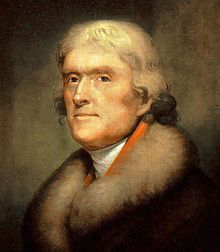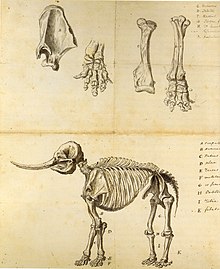Rembrandt Peale
Rembrandt Peale (born February 22, 1778 in Bucks County , Pennsylvania , † October 3, 1860 in Philadelphia ) was an American painter and son of the painter Charles Willson Peale . His most important works include portraits of George Washington (1795) and Thomas Jefferson, as well as a portrait of his brother Rubens: Rubens Peale with a Geranium .
Childhood and youth
Peale grew up around the time the USA was founded. However, according to the reports available, the major political events of this period seem to have hardly influenced him. Rather, the artistic environment of his father, who had a studio and his own museum in Philadelphia , was formative. Charles Willson Peale took his children's names from The Gentleman's and Connoisseur's Dictionary of Painters by Matthew Pilkington. So were Rembrandt's older surviving siblings Raphaelle and Angelica Kauffmann, the younger ones Titian Ramsay , Rubens, Sophonisba Angusciola and Rosalba Carriera. Rembrandt Peale shared an interest in music with his father.
In 1787, the year of the Philadelphia Convention , Rembrandt Peale was able to see his father portraying Washington. In 1790 his mother died and he left school. His first oil painting, a self-portrait, was created in 1791.
In 1794 Charles Willson Peale made efforts to found an art academy. Although these were ultimately not crowned with success, there was still an exhibition (Columbian exhibition) in which Rembrandt Peale showed 6 paintings and offered them for sale: In addition to the View of the Lutheran Church on Fire , the portraits of Samuel Buckley Morris , a self-portrait (presumably in candlelight), Portrait of a Young Gentleman (possibly a self-portrait from 1791) and Portrait of a Gentleman .
In 1795 Peale had the opportunity to make a portrait of George Washington. There are various anecdotes about the circumstances, but little is known. He soon took this painting with him to Charleston and made at least ten copies there.
Raphaelle Peale had also gone to Charleston and both benefited from Charles Willson Peales' connections in that city. They set up an exhibition with an entrance fee. The brothers' next stop was Savannah , but by the summer of 1796 they returned to Philadelphia.
With the support of their father, the brothers opened a museum in Baltimore that exhibited various curiosities in addition to paintings and stuffed animals. During this time Rembrandt Peale painted various paintings, but the museum had to be sold after a short time.
In 1798 Rembrandt Peale tried to establish the exhibition in New York , but soon failed and returned to Philadelphia, where he soon married and then toured Maryland for some time .
In 1800/1801 Peale made a portrait of President Jefferson, which became the model for engravings, cartoons and copies by other artists.
In 1801, Peale was involved in the excavation of two mammoths operated by his father. In addition to Peale and his father, William Rush was also involved in the reconstruction of the skeletons .
Travel to Europe
The exhibition of the second skeleton was intended to finance Rembrandt and Rubens Peale's trip to Europe. The first step was an exhibition in New York. This is also where the first of three essays that Rembrandt Peale wrote about the find was written: A Short Account of the Behemoth or Mammoth . From New York they traveled on to London , where Rembrandt wrote the Account of the Skeleton of the Mammoth, a Non-Descript Carnivorous Animal of Immense Size, Found in America . In addition to the exhibition of the skeleton and other duplicates from the American museum, the trip served to further educate Rembrandt Peale as a painter. Benjamin West was a sponsor . Contact with Joseph Banks was also useful . The London exhibition did not provide the necessary funds to travel to other European countries - as planned - and so the Peales returned to America after stopping at Reading and Bristol .
In 1804 Peale exhibited the mammoth in various American cities. After that he returned to painting. In 1805, he and his father helped set up the Pennsylvania Academy of the Fine Arts .
Peale's wish to see Paris and the Louvre came true in 1808 when his father commissioned him to paint portraits of important French people. This first stay in Paris lasted only 3 months and was dedicated to the old masters and portrait painting.
During his second stay in Paris from October 1809 to November 1810, Peale discovered encaustic for himself . For example, his portrait of Alexander von Humboldt is painted using this technique. Further topics of this trip were anatomy studies and history painting.
In 1826 Rembrandt Peale was one of the founders of the National Academy of Design and was elected honorary member ( Honorary NA ) the following year .
Two years later, from 1828 to 1830 - after stays in Baltimore, New York and Boston - Peale left for Italy with his son Michael Angelo. Stops were Naples , Rome , Florence , Milan , Genoa , Parma , Bologna , Ferrara , Venice and other places. Peale admired neoclassical art, in his view the highest art form. The return journey took place via Geneva , Paris and London.
In 1831 Peales Notes on Italy were published. In 1832/1833 he stayed again in England.
Baltimore Museum
In 1811 Peale opened his own admission-fee gallery in Philadelphia, in which he exhibited portraits as well as mythological, historical and landscape paintings. In 1812 The Roman Daughter added this gallery. An accusation of plagiarism weighed on Peale so badly that he decided to turn his back on Philadelphia and open a museum in Baltimore.
The museum opened in 1814. In addition to the mammoth and many stuffed animals, there was a picture gallery. In 1816 the museum was equipped with gas lighting, which benefited the number of visitors. Peale also received numerous portrait commissions during the Baltimore period and painted some of his best works. In spite of the American prudery and probably also because of the competition from another museum, files were also issued. In 1817 Peale founded the Baltimore Gas Light Company, whose purpose was city lighting. In 1822 Rubens Peale took over the museum and Rembrandt Peale left the city.
Later years
Peale's wife died in 1836. In 1840 he remarried and enlisted in Philadelphia Central High School . The result was a publication called Graphics , which saw several editions and was constantly expanded.
Peale lectured and made copies of his Washington portrait.
In 1860 he suffered a heart attack. He died surrounded by his daughters and his wife.
Works
-
John Witherspoon , 1794, oil on canvas, 88.9 × 76.2 cm, National Portrait Gallery, Smithsonian Institution, Washington, DC
- Copy of a portrait of John Witherspoon (1723–1794) by Charles Willson Peale, painted for the widow Witherspoon
-
George Washington , 1795, oil on canvas, 38.7 × 28.9 cm, Historical Society of Pennsylvania, Philadelphia
- Peale made numerous copies of this painting
-
Thomas Jefferson , 1800, oil on canvas, 58.7 × 48.9 cm, The White House, Washington, DC
- The best known and most copied portrait of the third American president until 1805
-
Rubens Peale with a Geranium , 1801, oil on canvas, 71.8 × 61 cm, National Gallery of Art, Washington, DC
- The painting was created by Rembrandt and Rubens Peale during the preparations for their trip to London
-
Joseph Banks 1803, oil on canvas, 71.1 × 58.4 cm, Library, The Academy of Natural Sciences of Philadelphia
- The picture was taken during Rembrandt Peale's stay in London
-
Gilbert Stuart , 1805, oil on canvas, 59.7 × 49.4 cm, The New York Historical Society, New York City
- Both Charles Willson Peale and Rembrandt Peale worked on this painting
-
Napoleon Bonaparte , 1810, oil on canvas, 66 × 53.3 cm
- Since Napoleon was not his model, Peale was dependent on observations during Napoleon's public appearances
-
Harper's Ferry , 1811, watercolor, 25.4 × 33 cm, The Baltimore City Life Museums, Maryland
- An oil painting was created on the basis of the watercolor
-
The Roman Daughter , 1811, oil on canvas, 215.3 x 159.7 cm, National Museum of American Art, Smithsonian Institution, Washington, DC
- The painting was advertised by Peale as a historical painting "as large as life"
-
Court of Death , 1820, oil on canvas, 350.5 × 713.7 cm, The Detroit Institute of Arts, Michigan
- The painting was part of Peale's effort to pay off the debt from his museum
-
Patriae Pater (George Washington) , 1824, oil on canvas, 176.5 × 133.4 cm, United States Senate Collection, Washington, DC
- Model for at least 75 copies in oil and a number of lithographs
-
Washington before Yorktown , 1824, oil on canvas, 91.4 × 73.7 cm, private collection
- Lafayette, Alexander Hamilton, Henry Knox and Count Rochambeau are pictured alongside Washington
-
Judith with the Head of Holofernes , 1830, oil on canvas, 140.5 × 112.1 cm, The Art Museum, Princeton University, Princeton, New Jersey
- The painting is a copy of the painting by Cristofano Allori
-
Girl at the Window (Rosalba Peale; The Burgomaster's Daughter) , 1846, oil on canvas, 76.2 × 63.5 cm, El Paso Museum of Art, Texas
- The painting was based on a template by Rembrandt van Rijn
literature
- Lillian B. Miller, In Pursuit of Fame: Rembrandt Peale 1778--1860 , National Portrait Gallery Smithsonian Institution, Washington, DC, 1992, ISBN 0-295-97243-2
Web links
- Works by Rembrandt Peale at Zeno.org .
- Rembrandt Peale at Artcyclopedia.com
- Rembrandt Peale at The Athenaeum
Individual evidence
- ↑ Lillian B. Miller, In Pursuit of Fame , pp. 10f.
- ↑ Lillian B. Miller, In Pursuit of Fame , pp. 30f.
- ^ Lillian B. Miller, In Pursuit of Fame , p. 47
- ^ Nationalacademy.org: Past Academicians "P" / Peale, Rembrandt Founder NA 1826; Honorary 1827 ( Memento of the original from January 26th, 2014 in the web archive archive.today ) Info: The archive link was automatically inserted and not yet checked. Please check the original and archive link according to the instructions and then remove this notice. (accessed on July 10, 2015)
- ^ Lillian B. Miller, In Pursuit of Fame , p. 199
| personal data | |
|---|---|
| SURNAME | Peale, Rembrandt |
| BRIEF DESCRIPTION | American portrait painter |
| DATE OF BIRTH | February 22, 1778 |
| PLACE OF BIRTH | Bucks County , Pennsylvania |
| DATE OF DEATH | October 3, 1860 |
| Place of death | Philadelphia |




